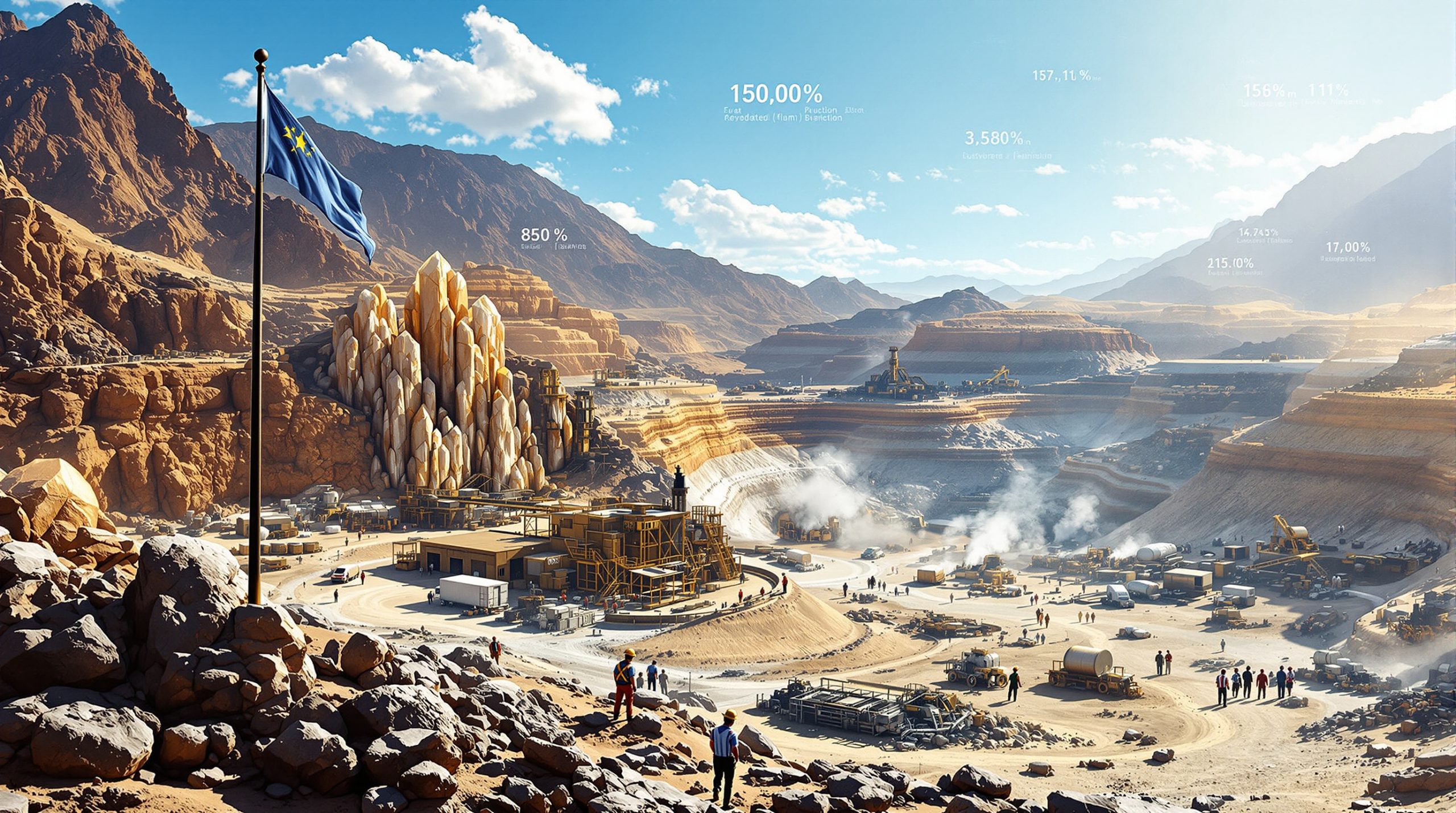Understanding the AI-Driven Transformation in Junior Mining Investment Analysis
The integration of artificial intelligence in junior mining investing represents a fundamental shift in how investment professionals evaluate early-stage mining opportunities. Traditional approaches that rely heavily on manual data analysis and subjective assessments are being supplemented by AI-powered systems capable of processing vast amounts of geological, financial, and market data to identify patterns that human analysts might miss.
During the current bull market cycle, where the GDXJ (VanEck Junior Gold Miners ETF) has delivered approximately 150% returns year-to-date, the challenge of differentiating quality projects has intensified. Investment analyst Joe Mazumrek notes that in such markets, virtually every junior mining company gains access to capital, making sophisticated analytical tools increasingly valuable for distinguishing between sustainable opportunities and marginal plays.
Core Components of AI-Enhanced Mining Investment Analysis
Modern AI applications in junior mining focus on several critical areas that address the unique challenges of early-stage project evaluation. Furthermore, the evolution of AI transforming drilling techniques has created new opportunities for more precise geological analysis:
-
Geological data interpretation through machine learning algorithms that analyze mineral deposit characteristics
-
Financial risk modeling using predictive analytics to assess project viability and capital requirements
-
Market sentiment analysis leveraging natural language processing to gauge investor confidence and market dynamics
-
Operational efficiency forecasting through pattern recognition in historical mining data and comparable project analysis
Investment professionals are discovering that AI tools can accelerate the compilation of comparative databases that previously required extensive manual research. However, experienced analysts emphasize that these systems serve as accelerators rather than replacements for human expertise and verification protocols.
The Technology Stack Behind AI Mining Analysis
The technological infrastructure supporting AI-enhanced mining investment analysis combines multiple data sources and analytical approaches. In addition, the mining industry evolution has accelerated the adoption of these technologies:
| Technology Component | Application in Mining Investment | Current Limitations |
|---|---|---|
| Machine Learning Models | Predict resource grade distributions and extraction costs | Requires extensive historical data validation |
| Natural Language Processing | Analyse technical reports and regulatory filings | Accuracy concerns with complex geological terminology |
| Computer Vision | Interpret satellite imagery and geological surveys | Limited availability for early-stage projects |
| Predictive Analytics | Forecast commodity price movements and market cycles | Difficulty incorporating geopolitical risk factors |
The evolution of these technologies has accelerated over the past three years, with basic applications like grammar and spell-checking serving as entry points for more sophisticated analytical capabilities. According to Forbes Business Council, "AI search is the new drill bit" for junior mining companies prioritising digital visibility.
What Makes AI Particularly Valuable for Junior Mining Due Diligence?
The unique characteristics of junior mining companies create specific challenges that make AI assistance particularly valuable. These early-stage entities often lack extensive operational histories, making traditional financial analysis insufficient for comprehensive investment evaluation.
Overcoming Information Asymmetries in Early-Stage Projects
AI systems excel at synthesising fragmented information from multiple sources to create comprehensive investment profiles. This capability proves crucial when evaluating pre-discovery or early-discovery stage projects where limited data availability creates significant information gaps.
Investment professionals report that AI can expedite the process of building comparative databases for specific project types. For example, when analyzing an open-pit copper development project, AI can rapidly compile grade and tonnage data from similar projects worldwide, providing context that would previously require weeks of manual research. Moreover, junior mining strategies increasingly incorporate AI-driven analysis to enhance decision-making.
Key advantages include:
-
Rapid processing of technical reports and geological surveys across multiple jurisdictions
-
Cross-referencing similar projects globally for comparative analysis and benchmarking
-
Identifying potential patterns in management track records and corporate governance
-
Assessing jurisdictional risks through comprehensive data aggregation from regulatory sources
However, the current market environment presents additional complexity. During bull market conditions, when financing rounds reach hundreds of millions of dollars with companies raising at valuations 170% higher than previous rounds within the same year, traditional screening criteria become less effective at identifying quality differentiators.
Enhanced Pattern Recognition for Resource Estimation
Critical Insight: AI algorithms can identify geological patterns across thousands of similar deposits worldwide, providing more accurate resource potential estimates than traditional methods when properly validated by qualified geologists.
This pattern recognition capability enables investors to compare target properties against successful historical discoveries, though experienced professionals emphasise the necessity of independent verification. The technology proves particularly valuable for:
-
Comparing target properties against successful historical discoveries in similar geological settings
-
Identifying optimal drilling locations based on geological signatures and structural patterns
-
Assessing the probability of resource expansion beyond initial estimates through statistical modeling
-
Evaluating technical feasibility of extraction methods based on comparable operations
Investment professionals note that whilst AI provides valuable preliminary insights, geological interpretation requires human expertise to validate outputs and identify potential errors in automated analysis.
How Are Investment Professionals Currently Implementing AI Tools?
The practical application of artificial intelligence in junior mining investing varies significantly based on investor sophistication, resource availability, and experience level. Current implementation strategies focus on leveraging AI to enhance rather than replace traditional due diligence processes.
Database Development and Comparative Analysis
Professional investors are utilising AI to build comprehensive databases of comparable projects and companies, enabling rapid benchmarking of new opportunities against historical performance data. This approach has proven particularly effective during market cycles where gold equities provide approximately 2x leverage to underlying commodity price movements. Consequently, contrarian junior mining approaches are gaining traction.
Implementation strategies include:
-
Creating automated systems for extracting key data points from technical reports
-
Building comparative databases of open-pit and underground projects by commodity type
-
Developing grade and tonnage models for different deposit types and geological settings
-
Establishing risk assessment frameworks for various mining jurisdictions
Investment professionals report that AI can significantly reduce the time required for initial data compilation. Where comparative analysis previously required extensive manual research, AI systems can provide preliminary datasets that serve as starting points for deeper investigation.
Verification and Validation Protocols
Despite AI's analytical capabilities, experienced investors emphasise the critical importance of verification processes. Industry professionals with decades of experience report questioning AI outputs and requiring independent verification before incorporating insights into investment decisions.
Best practices involve:
-
Cross-referencing AI outputs with independent geological assessments and expert opinions
-
Validating financial projections through traditional due diligence methods and management interviews
-
Confirming management team credentials and track records through personal networks
-
Conducting on-site visits to verify AI-based property assessments and operational capabilities
A critical risk management principle emphasised by practitioners is that if investors accept AI results without verification and present them as authoritative, responsibility for any inaccuracies lies with the analyst who failed to validate the data.
Which Specific AI Applications Show the Greatest Promise for Mining Investments?
Several AI applications have demonstrated particular effectiveness in improving junior mining investment outcomes, with varying levels of adoption across the investment community based on technical complexity and resource requirements.
Automated Technical Report Analysis
AI systems can rapidly extract and analyse key data points from lengthy technical reports, significantly reducing the time required for initial project evaluation. This capability proves especially valuable given the volume of technical documentation generated by junior mining companies during exploration and development phases.
Current capabilities include:
-
Resource estimate extraction and comparative benchmarking against similar projects
-
Capital cost analysis and validation against industry standards
-
Operational parameter identification and feasibility assessment
-
Risk factor categorisation and systematic assessment protocols
Investment professionals report that AI tools are beginning to process multiple technical reports simultaneously, enabling comparative analysis across project portfolios. However, this application remains in early development stages and requires continuous refinement. Furthermore, data-driven operations are becoming the standard for modern mining investment analysis.
Geological Modelling and Exploration Optimisation
Advanced AI applications assist in predicting resource continuity and identifying optimal exploration targets, potentially reducing both the time and cost of discovery. This proves particularly valuable for grassroots exploration projects where initial geological data may be limited.
| AI Application | Investment Benefit | Risk Consideration |
|---|---|---|
| Geological Pattern Recognition | Faster target identification and drilling optimisation | Requires validation by qualified professional geologists |
| Resource Continuity Modelling | Improved confidence in resource estimates | May overestimate continuity based on limited data points |
| Drilling Optimisation | Reduced exploration costs and improved efficiency | Cannot replace field expertise and geological judgment |
| Grade Distribution Prediction | Enhanced economic modelling capabilities | Heavily dependent on data quality and sample representativeness |
The technology shows promise for analysing projects with widely spaced drill holes across large trends, helping investors evaluate the potential for significant resource expansion beyond initial estimates.
What Are the Limitations and Risks of AI-Driven Mining Investment Analysis?
Whilst artificial intelligence in junior mining investing offers significant advantages, understanding its limitations remains crucial for making informed investment decisions. Industry professionals emphasise that AI tools should enhance rather than replace human expertise and judgment.
Data Quality and Availability Constraints
AI systems are only as effective as the data they process, and in junior mining, data limitations can significantly impact analytical accuracy. Several critical constraints affect AI performance:
-
Historical bias: AI models may perpetuate past market inefficiencies or analytical blind spots
-
Limited datasets: Early-stage projects often lack sufficient historical data for reliable AI analysis
-
Quality variations: Inconsistent data standards across different sources and jurisdictions
-
Geographic gaps: Limited AI training data from certain mining jurisdictions or geological settings
Investment professionals report instances where AI systems can have moments where they go off on tangents and provide results that don't align with analytical objectives, highlighting the need for continuous oversight.
The Human Expertise Requirement
Industry Perspective: Successful AI implementation in mining investment requires continuous human oversight and geological expertise to validate outputs and identify potential errors or limitations.
Critical areas requiring human judgment include:
-
Geological interpretation and validation of AI-generated geological models
-
Management team assessment and comprehensive due diligence protocols
-
Political and regulatory risk evaluation based on jurisdiction-specific knowledge
-
Market timing and investment strategy decisions incorporating macroeconomic factors
Experienced practitioners note that even professionals with decades of industry experience and natural market intuition find it necessary to question and verify AI outputs, suggesting that less experienced investors face even greater risks from over-reliance on automated analysis.
How Does AI Impact Market Efficiency in Junior Mining Investments?
The introduction of AI tools into junior mining investment creates complex effects on market efficiency, with potential benefits and drawbacks for different types of investors depending on their sophistication and implementation capabilities.
The Skill Gap Amplification Effect
Industry analysis suggests that AI adoption may increase rather than decrease market inefficiencies by amplifying the advantages of skilled investors whilst potentially misleading less experienced participants. This dynamic becomes particularly pronounced during market cycles with universal capital access.
Market dynamics include:
-
Enhanced analytical capabilities for sophisticated investors with proper AI implementation protocols
-
Increased complexity barriers for retail investors lacking technical expertise
-
Potential for greater price volatility due to algorithmic trading and automated decision-making
-
Widening performance gaps between professional and amateur investors
The challenge becomes more acute during bull markets when stock picking becomes difficult because virtually everything appreciates. Investment professionals note that distinguishing between quality projects and marginal opportunities requires sophisticated analysis that AI can support but not replace.
Information Processing Speed Advantages
AI-enabled investors can process and act on new information significantly faster than traditional analysis methods allow, potentially creating temporary competitive advantages in identifying opportunities or avoiding risks.
Competitive advantages:
-
Rapid response to new geological discoveries and drilling results
-
Faster identification of management changes or corporate developments
-
Immediate analysis of regulatory changes affecting specific mining jurisdictions
-
Quick assessment of commodity price impacts on individual project economics
However, experienced practitioners note that sentiment analysis, often marketed as an AI application, tends to be a lagging indicator. By the time sentiment shifts are identified, market movements have often already occurred.
What Investment Strategies Work Best When Combining AI with Traditional Analysis?
Successful integration of artificial intelligence in junior mining investing requires strategic approaches that leverage technological capabilities whilst maintaining essential human oversight and geological expertise.
Hybrid Analysis Frameworks
The most effective investment strategies combine AI-generated insights with traditional due diligence methods, creating comprehensive evaluation frameworks that capitalise on both speed and accuracy.
Framework components:
-
AI-powered initial screening and ranking systems for project evaluation
-
Traditional geological and financial due diligence verification processes
-
Management team assessment through personal interviews and reference checks
-
On-site property visits and independent technical validation by qualified professionals
Investment professionals emphasise that AI tools enable individual investors to compete without requiring large analytical teams. The technology serves as a force multiplier, allowing smaller investment operations to process information more efficiently whilst maintaining quality standards.
Risk Management Through Technology Integration
AI tools can enhance risk management capabilities by providing early warning systems and continuous monitoring capabilities for portfolio companies, particularly valuable during volatile market conditions.
| Risk Category | AI Application | Traditional Complement |
|---|---|---|
| Geological Risk | Pattern analysis and resource modelling | Expert geological review and field validation |
| Financial Risk | Cash flow and funding requirement predictions | Management interviews and financial audits |
| Political Risk | News sentiment and regulatory change tracking | Local expertise consultation and government relations |
| Market Risk | Price volatility and correlation analysis | Fundamental market research and macroeconomic analysis |
Successful implementation requires accepting certain risk factors inherent in AI systems, including occasional analytical tangents or unexpected results, whilst maintaining verification protocols to ensure accuracy and reliability.
How Should Investors Evaluate AI-Enhanced Mining Investment Platforms?
As AI-powered investment tools become more prevalent in junior mining analysis, investors need structured frameworks for evaluating the quality, reliability, and appropriateness of these platforms for their specific needs and expertise levels.
Platform Assessment Criteria
Key factors to consider when evaluating AI-enhanced mining investment platforms include technical capabilities, transparency, and track record validation:
-
Data source transparency: Clear identification of information sources, update frequencies, and data validation protocols
-
Algorithm explainability: Ability to understand how AI reaches specific conclusions and recommendations
-
Validation track record: Historical accuracy of AI predictions and recommendations with documented case studies
-
Human oversight integration: Clear roles for human experts in the analysis process and verification protocols
Investment professionals note that platforms offering sentiment analysis may provide value for investors lacking extensive market tracking capabilities, though such tools typically represent lagging indicators rather than predictive insights.
Due Diligence on AI Investment Tools
Important Consideration: Investors should treat AI investment platforms as analytical tools requiring verification rather than definitive investment advice sources, regardless of marketing claims or apparent sophistication.
Evaluation checklist:
-
Review the technical expertise and industry experience of platform developers
-
Assess the quality and comprehensiveness of underlying databases and data sources
-
Understand the limitations and assumptions built into AI models and algorithms
-
Verify the platform's track record with independent case studies and user testimonials
-
Evaluate the cost-effectiveness compared to traditional analysis methods
Experienced practitioners emphasise that AI systems can become concerning when they begin asking questions or making suggestions about analysis formats, highlighting the importance of maintaining analytical control and independence.
What Does the Future Hold for AI in Junior Mining Investment?
The evolution of artificial intelligence applications in junior mining investment continues to accelerate, with emerging technologies promising enhanced analytical capabilities whilst raising new questions about market structure and investment approaches. According to Junior Mining Network's AI section, the integration of AI technologies in mining operations is expanding rapidly across exploration, development, and operational phases.
Emerging Technologies and Applications
Several technological developments may further transform junior mining investment analysis capabilities over the coming years:
-
Advanced satellite imagery analysis for real-time monitoring of exploration activities and infrastructure development
-
Blockchain integration for transparent and verifiable data sharing across mining projects and stakeholders
-
Quantum computing applications for complex geological modelling and resource optimisation
-
IoT sensor networks providing real-time operational data from active mining sites and exploration programs
The integration of these technologies may enable more sophisticated pattern recognition and predictive modelling, though the fundamental requirement for human expertise and verification will likely remain constant.
Market Structure Evolution
The increasing adoption of AI tools may fundamentally alter the junior mining investment landscape through several potential developments:
Potential changes include:
-
Greater emphasis on data quality and standardisation across the mining industry
-
Increased collaboration between technology companies and mining industry experts
-
Evolution of new investment products and strategies leveraging AI insights
-
Enhanced regulatory frameworks addressing AI-driven investment decisions and recommendations
The trend toward critical minerals and security-related commodities, driven by government funding programmes and strategic initiatives, may accelerate AI adoption as investors seek to identify opportunities in complex, rapidly evolving markets.
Critical Minerals and Government Funding Impact on AI Implementation
Recent developments in critical minerals markets demonstrate how AI tools can help investors navigate rapidly changing government policies and funding priorities. The shift from general critical minerals to security minerals has created new investment opportunities requiring sophisticated analysis.
Government Investment Patterns
Department of Defense and similar agencies have demonstrated willingness to invest substantial capital in strategic mineral projects, creating significant market movements that AI systems may help identify earlier:
-
Trilogy Metals experienced over $700 million in market cap addition overnight following Department of Defense investment announcement
-
Perpetual Resources has secured potential funding for 70-80% of upfront capital in exchange for 10-15% of life-of-mine revenue on antimony production
These developments highlight markets where AI pattern recognition might identify emerging opportunities in rare earths, antimony, tungsten, and other security-critical commodities before widespread market recognition occurs.
Processing and Market Access Considerations
AI analysis must incorporate the reality that success in critical minerals extends beyond mining to include processing capabilities and market access. Investment evaluation requires understanding whether management teams possess the expertise and relationships necessary to bring products to market in domestic supply chains.
The complexity of these markets, involving geopolitical considerations, processing requirements, and rapidly evolving government policies, demonstrates the importance of combining AI analytical capabilities with deep industry expertise and regulatory understanding.
Practical Implementation Guide for Individual Investors
Individual investors seeking to incorporate artificial intelligence in junior mining investing should follow structured approaches that balance technological capabilities with personal expertise levels and risk tolerance.
Starting with Basic AI Tools
Beginning investors can start with accessible AI applications before advancing to more sophisticated analytical platforms:
-
Automated news aggregation for tracking company developments and regulatory changes
-
Basic sentiment analysis tools for market mood assessment, whilst recognising their lagging nature
-
Simple comparative analysis platforms for benchmarking investment opportunities
-
Educational AI assistants for learning mining industry fundamentals and terminology
Building AI-Enhanced Investment Processes
Step-by-step implementation:
-
Define investment criteria and risk tolerance parameters based on experience level and capital availability
-
Select appropriate AI tools based on technical sophistication and budget constraints
-
Establish verification protocols for all AI-generated insights and recommendations
-
Create systematic review processes for ongoing portfolio monitoring and evaluation
-
Continuously refine approaches based on performance outcomes and technological developments
Individual investors should recognise that AI tools can provide leverage similar to having larger analytical teams, enabling more comprehensive analysis without requiring extensive human resources. However, the responsibility for verification and decision-making remains with the investor.
Risk Management and Verification Protocols
The implementation of AI tools requires accepting certain inherent risks whilst establishing protocols to minimise potential negative impacts:
-
Accept occasional AI tangents or unexpected results as part of the technology's current limitations
-
Never present AI results as definitive without independent verification and validation
-
Maintain analytical independence when AI systems begin suggesting formats or approaches
-
Combine AI insights with traditional geological and financial due diligence methods
Further Exploration: Investors interested in practical applications of technology in mining investment analysis should focus on building foundational knowledge of geological concepts, financial modelling, and market dynamics whilst gradually incorporating AI tools as analytical accelerators rather than decision-makers.
The integration of artificial intelligence in junior mining investing represents a significant evolution in analytical capabilities, offering individual investors access to sophisticated tools previously available only to large institutional players. Success requires balancing technological advantages with essential human judgment, geological expertise, and comprehensive due diligence protocols. As markets evolve and AI capabilities advance, investors who master this hybrid approach may find themselves better positioned to identify quality opportunities and avoid common pitfalls in the challenging but potentially rewarding world of junior mining investment.
Ready to Leverage AI for Your Next Mining Discovery?
Discovery Alert's proprietary Discovery IQ model harnesses artificial intelligence to instantly identify significant ASX mineral discoveries, transforming complex geological data into actionable investment opportunities ahead of the broader market. Experience how AI-driven analysis can enhance your junior mining investment strategy by beginning your 30-day free trial today and positioning yourself at the forefront of mining discovery intelligence.




